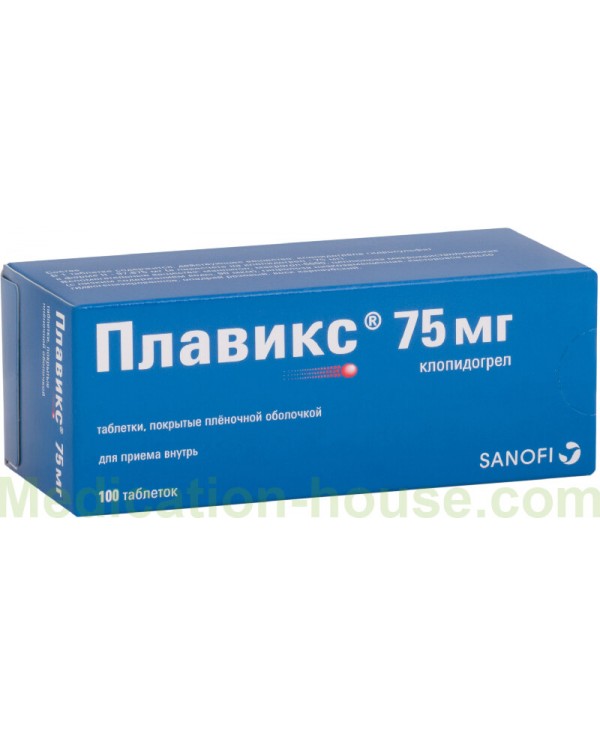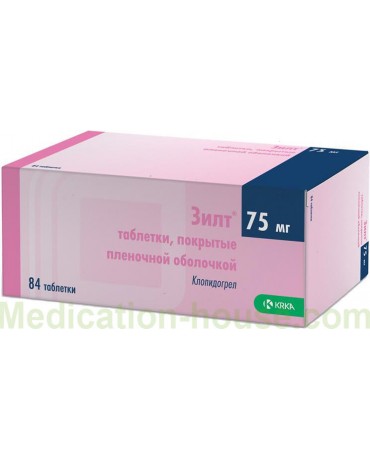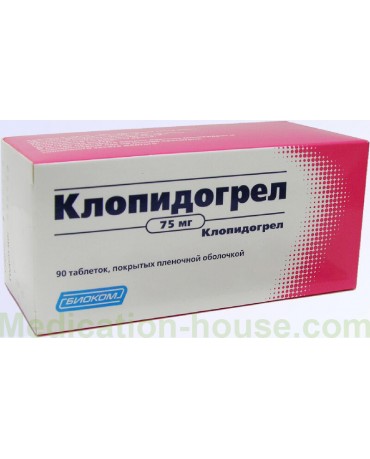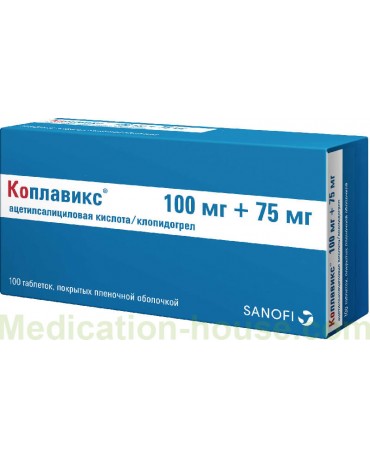Plavix user manual
To buy Plavix just add it to your shopping cart
Plavix is a drug used to reduce blood clots by inhibiting platelet aggregation.
Release form and composition
Plavix is produced in the form of film-coated tablets:
dosage of 75 mg: slightly biconvex, round, pink, engraved with "I I7I" on one side and "75" on the other (7 or 14 pcs. in a blister, in a cardboard box 1, 2 or 3 blisters; 10 pcs. in a blister, in a cardboard box 1, 2, 3 or 10 blisters);
dosage of 300 mg: oblong, pink, engraved with "1332" on one side and "300" - on the other (10 pcs. in a blister, in a cardboard box 1 or 3 blisters).
1 tablet contains:
active substances: clopidogrel hydrogen sulfate in form II - 97.875 or 391.5 mg (which is equivalent to the content of 75 and 300 mg of clopidogrel, respectively);
additional components: microcrystalline cellulose (with a low water content, 90 microns), macrogol 6000, hydrogenated castor oil, mannitol, low-substituted hyprolose;
film shell: Opadry pink [hypromellose, lactose monohydrate, triacetin, titanium dioxide (E171), iron dye red oxide (E172)], carnauba wax.
Pharmacodynamics
Clopidogrel is a prodrug in which one of the metabolites is active and inhibits platelet aggregation (aggregation). This metabolite of clopidogrel selectively inhibits the binding of adenosine diphosphate (ADP) to the P2Y12 receptor on the platelet surface and further activation of the glycoprotein IIb / IIIa complex mediated by ADP. As a result, platelet aggregation is blocked, which, due to irreversible binding, during the remaining life cycle (approximately 7–10 days) lose their susceptibility to ADP stimulation.
The process of restoring normal platelet function proceeds at a rate corresponding to the rate of their renewal. There is also a suppression of platelet adhesion induced by other agonists by blocking the released ADP of their increased activation. Since the formation of the active metabolite of clopidogrel occurs with the participation of isoenzymes of the P450 system, some of which may differ in polymorphism and are suppressed by other drugs, adequate inhibition of platelet aggregation may not be observed in all patients.
With daily use of clopidogrel at a dose of 75 mg, from the first day of administration, a significant, ADP-induced inhibition of platelet aggregation is determined, which gradually increases over 3-7 days and reaches a constant level. In the equilibrium state of the drug, platelet aggregation is inhibited by an average of 40-60%. Approximately 5 days after the end of therapy, the initial level of platelet adhesion and the duration of bleeding are noted.
In the process of a small comparative study of the pharmacodynamic effects of clopidogrel in men and women, the latter showed less suppression of ADP-induced platelet aggregation, however, no differences in the lengthening of bleeding time were recorded. In a large controlled trial CAPRIE [clopidogrel versus acetylsalicylic acid (ASA) in patients with a threat of ischemic complications], in men and women, the frequency of clinical outcomes, adverse reactions and deviations of clinical and laboratory parameters from the norm were the same.
Clopidogrel prevents the development of atherothrombosis against the background of any localization of atherosclerotic vascular lesions, including with lesions of the coronary, cerebral or peripheral arteries.
According to ACTIVE-A clinical studies, in patients with atrial fibrillation who are unable to take indirect anticoagulants, and if they have at least one risk factor for vascular complications, clopidogrel in combination with ASA, in comparison with ASA alone, reduced the total risk of new ischemic events [a combined indicator of myocardial infarction (MI), stroke, systemic thromboembolism outside the vessels of the central nervous system, or vascular death] mainly by reducing the threat of stroke.
With recent MI, stroke or diagnosed peripheral arterial occlusive disease, taking Plavix in a daily dose of 75 mg significantly reduces the risk of ischemic complications. The greatest effectiveness in such cases is observed in patients with occlusive peripheral arterial disease, especially in combination with a history of myocardial infarction, as well as in patients under 75 years of age.
In patients with acute coronary syndrome without ST-segment elevation (MI, unstable angina), Plavix is taken at a loading dose of 300 mg, and then 75 mg per day in combination with ASA (75–325 mg once a day) and other standard therapies, regardless of concomitant treatments [lipid-lowering agents, heparin therapy, β-blockers, glycoprotein IIb / IIIa blockers, angiotensin-converting enzyme (ACE) inhibitors], significantly reduces the total risk of new ischemic events by 17% with conservative treatment, by 29% - after performing percutaneous transluminal coronary angioplasty (PTCA) with or without stenting, and by 10% after coronary artery bypass grafting.
In patients with acute myocardial infarction with ST segment elevation, the use of Plavix during the first 12 hours of myocardial infarction at a loading dose of 300 mg, and then 75 mg per day, combined with ASA (loading dose 150–325 mg, then 1 time per day, 75 –162 mg) and fibrinolytic (if necessary - with heparin), reduces the overall rate of occlusion of the infarct-dependent coronary artery, detected at discharge from the hospital, the development of recurrent myocardial infarction or death.
In patients with acute myocardial infarction, ST segment depression, ST segment elevation, left bundle branch block, the use of Plavix in a daily dose of 75 mg combined with ASA 162 mg once a day helps to reduce the frequency of deaths for any reason, and the combined frequency stroke, first recurrent myocardial infarction and death.
Pharmacokinetics
After single oral and course administration of Plavix at a dose of 75 mg, rapid absorption of the active substance is noted. The maximum concentration (Cmax) of unchanged clopidogrel in plasma (2.2–2.5 ng / ml) is observed approximately 45 minutes after oral administration. By the amount of excreted metabolites of clopidogrel in the urine, it can be concluded that at least 50% of the ingested substance is absorbed. Clopidogrel and its main inactive metabolite circulating in the blood reversibly bind to plasma proteins in vitro by 98% and 94%, respectively. This connection remains unsaturated and does not reach a concentration of 100 mg / ml.
The process of metabolic transformation of clopidogrel occurs in the liver, in vitro and in vivo, it proceeds in 2 ways:
By hydrolysis with esterase enzymes, with the formation of an inert derivative of carboxylic acid (covers 85% of all metabolites circulating in plasma).
With the participation of isoenzymes of the cytochrome P450 system. First, during the biotransformation of clopidogrel, an intermediate metabolite 2-oxo-clopidogrel is formed, further metabolism of which leads to the emergence of an active metabolite of clopidogrel, its thiol derivative. In vitro, this metabolite is formed mainly by the isoenzyme CYP2C19 and some other isoenzymes, including CYP3A4, CYP2B6 and CYP1A2.
The active thiol metabolite of clopidogrel, isolated in in vitro studies, quickly and irreversibly binds to platelet receptors, thereby inhibiting the aggregation of the latter. After a single dose of Plavix in a loading dose of 300 mg, the Cmax of a thiol derivative of clopidogrel is 2 times higher than that after 4 days of using the drug in a maintenance dose of 75 mg. Achieved Cmax 30-60 minutes after taking the drug.
Within 120 hours after oral administration of 14C-labeled clopidogrel, about 50% of the dose received is excreted through the kidneys in the urine, and about 46% through the intestines with feces. After taking 75 mg of Plavix, the half-life (T1 / 2) of clopidogrel is approximately 6 hours. With a single and repeated use of doses of the active substance, T1 / 2 of its main inactive metabolite circulating in the blood is 8 hours.
Pharmacogenetics
The active and intermediate metabolites (2-oxoclopidogrel) of clopidogrel are produced with the participation of the CYP2C19 isoenzyme. The antiplatelet effect and pharmacokinetics of the active metabolite of clopidogrel, according to the results of ex vivo platelet aggregation studies, depend on the genotype of the CYP2C19 isoenzyme.
Functional metabolism corresponds completely to the allele of the CYP2C19 * 1 gene, and non-functional alleles include CYP2C19 * 3 and CYP2C19 * 2. The presence of the latter leads to a deterioration in the metabolic process in the majority of representatives of the Caucasian (85%) and Mongoloid (99%) races. Other alleles associated with the absence / decrease of metabolism are much less common, such as CYP2C19 * 4, * 5, * 6, * 7 and * 8. With a weak activity of the isoenzyme CYP2C19, patients have two of the above non-functional alleles. According to published data, the CYP 2C19 genotypes responsible for reduced metabolism are found in 2% of Caucasians, 4% of Negroids, and 14% of Chinese.
Special tests are currently available to determine the patient's CYP 2C19 genotype.
Evaluation of the effect of the CYP2C19 genotype on clinical results in patients taking clopidogrel in the course of randomized, prospective, controlled studies has not been conducted.
The prevalence of alleles of the CYP2C19 genes, which cause intermediate and low activity of this isoenzyme, depends on the race. The limited literature data on their prevalence in patients of the Mongoloid race does not allow us to assess in them the clinical significance of genotyping of the CYP2C19 isoenzyme for the occurrence of ischemic complications.
Indications for use
According to the instructions, Plavix is recommended for use (in combination with ASA) to prevent atherothrombotic complications in the presence of acute coronary syndrome:
with ST segment elevation (acute myocardial infarction), as well as for a dosage of 75 mg - with drug therapy and the possibility of thrombolysis;
without ST-segment elevation (MI without Q wave or unstable angina pectoris), including after stenting during percutaneous coronary intervention.
Plavix 75 mg is additionally indicated for the following purposes:
prevention of atherothrombotic complications in patients who have had myocardial infarction (in the period from several to 35 days after its onset), ischemic stroke (in the period from 7 days to 6 months after its onset), or in persons diagnosed with occlusive peripheral arterial disease;
prevention of thromboembolic and atherothrombotic complications, including stroke, in the presence of atrial fibrillation (atrial fibrillation), including patients with atrial fibrillation who have a low likelihood of bleeding, at least one risk factor for vascular complications, and the presence of contraindications to the use of indirect anticoagulants (in combination with ASK).
Contraindications
Absolute:
age under 18;
acute bleeding, including intracranial hemorrhage or bleeding from a peptic ulcer;
severe liver dysfunction;
glucose-galactose malabsorption syndrome, lactase deficiency, hereditary galactose intolerance;
pregnancy and breastfeeding period;
hypersensitivity to the active substance or any other additional component of the drug.
Relative (use Plavix tablets with extreme caution):
renal failure;
a moderate degree of liver failure, in which a predisposition to bleeding may be aggravated;
diseases in which there is a tendency to bleeding (mainly gastrointestinal or intraocular), and especially with the concomitant use of drugs that can provoke defects in the mucous membrane of the digestive tract, such as ASA and non-steroidal anti-inflammatory drugs (NSAIDs), including selective inhibitors COX-2 (due to the fact that clopidogrel increases bleeding time);
low activity of the isoenzyme CYP2C19;
the presence of an increased risk of bleeding due to surgery, trauma, or other pathological conditions, as well as in patients taking heparin, warfarin, glycoprotein IIb / IIIa inhibitors, ASA, NSAIDs, and other drugs whose therapy is associated with the threat of bleeding, selective serotonin reuptake inhibitors (SSRIs);
combination with agents related to substrates of the isoenzyme CYP2C8 (paclitaxel, repaglinide) due to the risk of an increase in their plasma concentrations;
recently suffered transient cerebrovascular accident or ischemic stroke (in combination with ASA);
hematological (neutropenia, thrombocytopenia) and allergic reactions (rash, angioedema) to other thienopyridines (ticlopidine, prasugrel), due to the risk of cross-hematological and allergic reactions (monitoring is recommended).
Instructions for the use of Plavix: method and dosage
Plavix is taken orally, regardless of the meal.
As a loading dose, patients with acute coronary syndrome are prescribed tablets at a dose of 300 mg; during maintenance therapy, Plavix 75 mg tablets are used.
The recommended dosage regimen of Plavix, depending on the indications:
acute coronary syndrome without ST-segment elevation (MI without Q wave on ECG or unstable angina): take a single loading dose of 300 mg, then continue therapy, taking 75 mg once a day and combining with ASA in a daily dose of 75-325 mg ; in view of the fact that the use of ASA in large doses aggravates the risk of bleeding, for this indication it is recommended to take it in a dose not exceeding 100 mg; the maximum therapeutic effect is noted 3 months after the start of admission, the course is up to 12 months;
acute coronary syndrome with ST segment elevation (acute myocardial infarction with ST segment elevation): take 75 mg once a day with an initial intake of a single loading dose of 300 mg in combination with ASA and thrombolytics (or without them); combined treatment begins immediately after the first symptoms of the lesion appear, the course is at least 4 weeks; when treating patients over 75 years old, a loading dose of clopidogrel is not prescribed; the effectiveness of the combination of clopidogrel and ASA over 4 weeks in this indication has not been studied;
ischemic stroke, MI, diagnosed occlusive peripheral arterial disease: take Plavix 75 mg tablets once a day;
atrial fibrillation: take 75 mg once a day, in combination with clopidogrel, you should start and then continue taking ASA in daily doses of 75-100 mg.
If the next dose is missed, if less than 12 hours have passed since the moment when it should have been used, you must immediately take the missed dose, and the next one at the usual time. If more than 12 hours have passed since the missed dose, it is recommended to take the next regular dose at the usual time (without doubling it).
A genetically determined decreased activity of the isoenzyme CYP2C19 is usually associated with a weakening of the antiplatelet effect of clopidogrel. The mode of using high doses (600 mg - loading, and then 150 mg - maintenance dose 1 time per day daily) with low activity of this isoenzyme increases the antiplatelet effect of the substance. However, the optimal dosage regimen of Plavix is currently not established for patients with a genetically determined reduced metabolism in studies evaluating clinical outcomes.
Side effects
The safety of Plavix was determined in clinical trials involving more than 44,000 patients, 12,000 of whom received the drug for a year or more. Tolerability of clopidogrel at a daily dose of 75 mg in the CAPRIE study was generally consistent with the tolerability of ASA at a dose of 325 mg per day, regardless of gender, age and race of patients.
The following are clinically significant undesirable effects that were noted during the study period:
nervous system: infrequently - dizziness, headache, paresthesia; rarely - vertigo;
digestive system: often - abdominal pain, diarrhea, dyspepsia; infrequently - vomiting, bloating, nausea, constipation, duodenal ulcer, gastritis, stomach ulcer;
hematopoietic system: infrequently - a decrease in the number of platelets / neutrophils in the peripheral blood, eosinophilia, leukopenia;
blood coagulation system: infrequently - lengthening of bleeding time;
dermatological reactions: infrequently - itching, rash.
Adverse reactions registered on the basis of post-marketing experience with the use of Plavix (with an unknown frequency):
hematopoietic system: aplastic pancytopenia / anemia, granulocytopenia, agranulocytosis, acquired hemophilia A, thrombotic thrombocytopenic purpura;
hemorrhagic disorders: some serious bleeding, in most cases such as musculoskeletal, subcutaneous, ocular hemorrhages (in the tissues and retina of the eye, conjunctival), bleeding from the respiratory tract (pulmonary hemorrhage, hemoptysis), nosebleeds, hematuria, bleeding from postoperative wounds ; cases of fatal bleeding (mainly intracranial or retroperitoneal hemorrhage, gastrointestinal bleeding);
digestive system: stomatitis, pancreatitis, colitis (including lymphocytic or ulcerative), hepatitis (non-infectious), acute liver failure;
respiratory system: bronchospasm, interstitial / eosinophilic pneumonia;
cardiovascular system: lowering blood pressure, vasculitis;
musculoskeletal system: arthralgia, myalgia, arthritis;
reproductive system and mammary gland: gynecomastia;
urinary system: glomerulonephritis;
allergic reactions: serum sickness, anaphylactoid reactions; cross-allergic / hematological reactions with other thienopyridines (ticlopidine, prasugrel);
nervous system: disturbances in taste perception;
mental disorders: hallucinations, confusion;
dermatological reactions: pruritus, erythematous / maculopapular / exfoliative rash, urticaria, angioedema, bullous dermatitis (Stevens-Johnson syndrome, erythema multiforme, toxic epidermal necrolysis), acute generalized exanthematic hypersensitivity pustules, eczema drug syndrome eosinophilia and systemic manifestations (DRESS syndrome);
laboratory and instrumental data: deviation from the norm of laboratory indicators of the functional state of the liver, an increase in the level of creatinine in the blood;
general disorders: fever.
Overdose
A symptom of an overdose of Plavix may be a prolongation of the bleeding period, and further complications in the form of bleeding. The antidote for clopidogrel is unknown.
With the development of bleeding, appropriate therapeutic measures are taken. For the rapid recovery of the prolonged bleeding time, if necessary, platelet transfusion is prescribed.
Special instructions
During therapy with Plavix, especially during the first weeks of the course and / or after invasive cardiological procedures or surgery, it is necessary to carefully monitor the patient's condition to identify any possible signs of bleeding, including latent.
Due to the existing risk of bleeding and hematological adverse reactions, when characteristic symptoms appear against the background of the use of Plavix, indicating possible bleeding, it is necessary to immediately make a clinical blood test, an analysis of the functional activity of platelets, establish an activated partial thromboplastin time (APTT), platelet count and others. necessary tests.
With the upcoming planned surgical intervention, if there is no need for an antiplatelet effect, 5-7 days before the operation, you should stop taking Plavix.
Patients should be informed that during the period of treatment with the drug (when monotherapy or when combined with ASA) it may take more than usual time to stop bleeding, and that they need to inform their doctor about any development of unusual bleeding (by location / duration) ... You should also tell your doctor (including your dentist) about taking clopidogrel before any surgery and before starting any new drug.
Very rarely, after taking Plavix (sometimes even short-term), there have been cases of thrombotic thrombocytopenic purpura (TTP), manifested by such disorders as thrombocytopenia and microangiopathic hemolytic anemia in combination with neurological manifestations, functional renal impairment or fever. Since TTP is a potentially life-threatening condition, when it occurs, urgent therapeutic measures are required, including the appointment of plasmapheresis.
With recent transient cerebrovascular accident or stroke and a high risk of recurrent ischemic complications, the combined use of clopidogrel and ASA leads to an increased incidence of major bleeding. Such combination treatment should be carried out with extreme caution and only with proven clinical benefits of its appointment.
During the course of therapy, cases of acquired hemophilia have been reported. If an isolated increase in APTT has been confirmed, accompanied or not accompanied by the development of bleeding, it is required to consider the possibility of acquired hemophilia. When confirming the diagnosis, it is necessary to refuse to take clopidogrel, be under the supervision of a specialist and receive appropriate treatment.
In patients with weak activity of the isoenzyme CYP2C19, when using Plavix in the recommended doses, there is a low plasma level of the active metabolite of clopidogrel, which causes its less pronounced antiplatelet effect. If such patients during the period of therapy usually take the recommended doses of clopidogrel, then with percutaneous coronary intervention or acute coronary syndrome, they have an increased risk of cardiovascular complications in comparison with patients in whom the normal metabolism of CYP2C19 is determined. In order to select a therapeutic strategy, available tests to establish the CYP2C19 genotype can be used.
Due to the lack of data on the use of clopidogrel against the background of an acute stroke less than 7 days old, Plavix is not recommended for this condition.
Influence on the ability to drive vehicles and complex mechanisms
The antiplatelet agent Plavix has no significant effect on the ability to drive vehicles and other complex and potentially dangerous equipment.
Application during pregnancy and lactation
In animal studies, no direct or indirect negative effect of clopidogrel on pregnancy, embryo / fetal development, childbirth and postnatal development has been established. But since it is not always possible to predict the reaction in humans based on the results of animal tests, and also due to the lack of data from adequately controlled clinical studies on the use of the drug in pregnant women, taking Plavix during pregnancy is contraindicated.
In animal studies, it was found that the drug and its metabolites penetrate into breast milk, therefore, during the period of therapy, breastfeeding should be discontinued.
Childhood use
Plavix is contraindicated for persons under 18 years of age, since there is no data on the effectiveness and safety of its use by patients of this age group.
With impaired renal function
Plavix should be used with caution in renal failure due to limited clinical experience.
For violations of liver function
Antiplatelet agents are contraindicated in patients with severe hepatic impairment.
In the presence of a moderate degree of liver failure, against which the potential risk of bleeding increases (due to limited clinical experience of use), Plavix is prescribed with extreme caution. During treatment, it is required to monitor the functional activity of the liver. In the case of severe lesions, it is required to take into account the likelihood of hemorrhagic diathesis.
Use in the elderly
Plavix therapy in elderly patients (over 75 years old) is recommended to start without using a loading dose.
Drug interactions
esomeprazole, omeprazole, and other proton pump inhibitors (PPIs); fluoxetine, fluvoxamine, voriconazole, moclobemide, ticlopidine, fluconazole, ciprofloxacin, carbamazepine, cimetidine, chloramphenicol oxcarbazepine, (strong and moderate inhibitors of the CYP2C19 isoenzyme): a decrease in the concentration of the active metabolite of clopidogel is possible; in view of the fact that the clinical significance of this interaction has not been clarified, it is recommended to avoid the combination of these agents with clopidogrel; if necessary, combined administration with PPIs, the latter should be used with the least suppression of the CYP2C19 isoenzyme, for example, pantoprazole and lansoprazole;
atenolol and / or nifedipine: there was no clinically significant pharmacodynamic interaction;
phenobarbital, estrogens: there was no significant change in the pharmacodynamic activity of clopidogrel;
digoxin, theophylline: there was no change in their pharmacokinetic parameters;
antacids: no decrease in the absorption of clopidogrel was found;
ACE inhibitors, β-blockers, hypolipidemic agents, diuretics, hypoglycemic agents (including insulin), slow calcium channel blockers, coronary vasodilators, hormone replacement therapy drugs, antiepileptic drugs, blockers of glycoprotein receptors IIb / IIIa-receptors were not detected clinically significant adverse effects;
tolbutamide, phenytoin; NSAIDs metabolized by the isoenzyme CYP2C9: a change in the metabolism of these drugs is unlikely.
Terms and conditions of storage
Keep out of the reach of children. Store at a temperature not exceeding 30 ° C.
Shelf life is 3 years.
Reviews
Reviews of Plavix are generally positive. Patients point to the high effectiveness of the antiplatelet agent when used to thin the blood in the event of a threat of blood clots. The advantages of the drug include the ability to take it regardless of the diet.
In rare cases, there are complaints about the development of undesirable effects during therapy in the form of diarrhea, flatulence, nausea, and dyspepsia. Almost everyone considers the disadvantage of the drug to be its high cost, and since sometimes the course of treatment can reach 12 months, some patients note that they had to replace Plavix after consulting a doctor with cheaper analogues.
Terms of sell
You can buy Plavix without a prescription.





